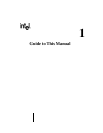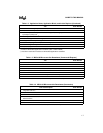
1-3
GUIDE TO THIS MANUAL
Appendix C — Registers — provides a compilation of all device special-function registers
(SFRs) arranged alphabetically by register mnemonic. It also includes tables that list the win-
dowed direct addresses for all SFRs in each possible window.
Glossary — defines terms with special meaning used throughout this manual.
Index — lists key topics with page number references.
1.2 NOTATIONAL CONVENTIONS AND TERMINOLOGY
The following notations and terminology are used throughout this manual. The Glossary defines
other terms with special meanings.
# The pound symbol (#) has either of two meanings, depending on the
context. When used with a signal name, the symbol means that the
signal is active low. When used in an instruction, the symbol prefixes
an immediate value in immediate addressing mode.
assert and deassert The terms assert and deassert refer to the act of making a signal
active (enabled) and inactive (disabled), respectively. The active
polarity (low or high) is defined by the signal name. Active-low
signals are designated by a pound symbol (#) suffix; active-high
signals have no suffix. To assert RD# is to drive it low; to assert ALE
is to drive it high; to deassert RD# is to drive it high; to deassert ALE
is to drive it low.
clear and set The terms clear and set refer to the value of a bit or the act of giving
it a value. If a bit is clear, its value is “0”; clearing a bit gives it a “0”
value. If a bit is set, its value is “1”; setting a bit gives it a “1” value.
instructions Instruction mnemonics are shown in upper case to avoid confusion.
In general, you may use either upper case or lower case when
programming. Consult the manual for your assembler or compiler to
determine its specific requirements.
italics Italics identify variables and introduce new terminology. The context
in which italics are used distinguishes between the two possible
meanings.
Variables in registers and signal names are commonly represented by
x and y, where x represents the first variable and y represents the
second variable. For example, in register Px_MODE.y, x represents
the variable that identifies the specific port associated with the
register, and y represents the register bit variable (7:0 or 15:0).
Variables must be replaced with the correct values when configuring
or programming registers or identifying signals.


















